Francesco75 (talk | contribs) (You can change the Age of Discovery section, it's just a term to regroup more section but I didn't think Feudal Japan can be considered as a part of the Age of Discovery) |
Francesco75 (talk | contribs) |
||
| Line 215: | Line 215: | ||
In 1582, as Oda was using the Sword for his own profit, the Assassin [[Yamauchi Taka]] killed him and gave the Sword to Liu Yan from the Chinese Brotherhood, who brought the artifact back to her country.<ref name="Memories"/> |
In 1582, as Oda was using the Sword for his own profit, the Assassin [[Yamauchi Taka]] killed him and gave the Sword to Liu Yan from the Chinese Brotherhood, who brought the artifact back to her country.<ref name="Memories"/> |
||
| − | ===Age of |
+ | ===Age of Enlightenment=== |
====Golden Age of Piracy==== |
====Golden Age of Piracy==== |
||
By 1699, the English privateer Captain [[William Kidd]] was in the possession of a [[Rings of Eden|Ring of Eden]] which could deflect any metal projectile, giving him a reputation to be invincible. The Templars tried to recover the artifact but Kidd hid it on the [[Oak Island]] leaving hints to four members of his former crew.<ref name="Oak Island">''[[Assassin's Creed III]]'' – [[Oak Island (memory)]]</ref> |
By 1699, the English privateer Captain [[William Kidd]] was in the possession of a [[Rings of Eden|Ring of Eden]] which could deflect any metal projectile, giving him a reputation to be invincible. The Templars tried to recover the artifact but Kidd hid it on the [[Oak Island]] leaving hints to four members of his former crew.<ref name="Oak Island">''[[Assassin's Creed III]]'' – [[Oak Island (memory)]]</ref> |
||
Revision as of 09:52, 24 April 2020
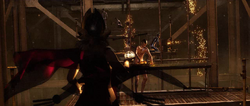
Humans being controlled by an Isu with an Apple of Eden
A Piece of Eden is a type of technologically sophisticated device created by the Isu which reacts with the network of neurotransmitters engineered into human brains. With the notable exception of the Shrouds of Eden, the majority of Pieces of Eden were designed for the primary purpose of mentally and physically controlling human thoughts, emotions, and behavior. They were therefore the main instrument by which the Isu forced the humans to serve as slave labor.
The powers of the Pieces of Eden have mystified humanity over millennia, enough for them to conflate them with "magic" throughout history. The extinction of the Isu civilization following the Great Catastrophe only reinforced this, as memories of the Isu for the humans faded into legends and myths. Since humans lack the technological expertise to reproduce these devices, they have long been the subject of innumerable conflicts between rival humans seeking them for their own ends. In particular, they are a central obsession of the Templar Order, which has devoted much of their resources for millennia searching and seizing these artifacts in their quest for world domination.
Description
Although the main classes of Pieces of Eden, such as the Apples and Staves of Eden, were utilized as tools by which humanity could be controlled, others deviated from this purpose. The Swords of Eden are primarily weapons capable of emitting energy blasts while the Shrouds of Eden are medical in nature, designed for healing even the most mortal of wounds. The diverse functions of the devices extend further: many are capable of bending the thoughts of one or more individuals to that of the user, projecting illusions or concealing the user's presence. The Precursor boxes, powered by other Pieces of Eden, can imprint the memories of its users onto others and decode examples of Isu script, like the Voynich manuscript. Other functions are more mundane relative to modern human technology, such as the projection of holograms or the Crystal Skulls which act as long-distance communication devices, but these nevertheless appeared supernatural to ancient peoples.
Since the end of the Isu civilization, these devices, appearing sporadically in the hands of humans, have acquired a status as legendary relics of phenomenal properties. Greatly eclipsing the technological level of human civilization, even into modern times, the Pieces of Eden bestow tremendous power over society to those who come to possess them. Their employment has therefore had immense impacts on human history; some of the most influential leaders such as Alexander the Great, Genghis Khan, Napoleon Bonaparte, and Mahatma Gandhi were aided by their use of a Piece of Eden.
Recognizing their significance, the Pieces of Eden have been at the forefront of the Templar Order's goals for centuries as they hope that by exploiting the artifacts, they could achieve their vision of a New World Order. The contest for the Pieces of Eden between the Templars and their archenemies, the Assassins, who traditionally seek to safeguard them, has been a hallmark of their millennia long war.
History
Isu era
The Pieces of Eden have a long history that punctuates the tales of humanity. During the War of Unification, the Isu Hephaistos created Swords of Eden for the conflict. His apprentice Consus created a Shroud of Eden to heal the soldiers.[1] He later put his consciousness in the artifact. The Apples of Eden were used to control humans, who were created by Phanes during the Project Anthropos to work as slaves for the Isu.[2] Humans react to the effects of the Pieces of Eden through a unique network of neurotransmitters implanted in the brain.[3]
The Isu Juno and her husband Aita used Atlantis artifacts on humans creating hybrids monster for the Olympos Project. When Poseidon learned this, he banished them from Atlantis, but they continued their experiments in secret.[2]

Eve holding an Apple of Eden
However, interbreeding between humans and members of the Isu led to the creation of a hybrid race, which was immune to the hypnotic effects of the Pieces of Eden. In 75,010 BCE, two of these hybrids, Adam and Eve, stole one of the Apples from their masters and escaped from captivity in Eden. Soon after, war broke out, pitting humanity against their creators.[3]
While the rest of the Isu were preoccupied with battling the humans, Jupiter, Juno and Minerva were tasked with finding a way to guard against the threat of an impending solar flare. They relocated to the Grand Temple in what is now Turin, New York[4], a facility which could only be entered using an Apple of Eden. Opening the Temple's inner gate required another Piece of Eden, namely the Grand Temple Key.[5]
By that time, the Isu were already able to generate small magnetic fields through the Shards of Eden, which were worn as rings. Using similar technology, they hoped to create a large magnetic field to protect the Earth from the sun's flare. However, they lacked the resources to do so, and though they attempted to create fields to protect small portions of the Earth, they were ultimately unsuccessful.[5]
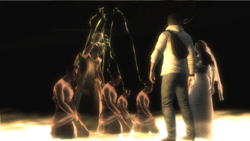
A projection of Jupiter controlling humans with an Apple of Eden
The Isu soon discovered that when enough humans sat in thrall of the Pieces of Eden and were forced to believe, their thoughts became reality. Jupiter, Juno and Minerva considered the possibility that they could use an agglomeration of focused human imagination to save the planet. This attempt was also deemed unsuccessful.[5]
As their third option, they sent an Apple of Eden into the orbit, and when it was placed, uttered the words "make us safe". When their first attempt failed, they resolved to send a dozen more after. This act was also met with failure as there was no way to direct the beams of energy emitted by the Pieces down to the Earth.[5]
Only ten years after the human rebellion began, the solar flare destroyed most of the Earth's surface and population, leaving roughly ten thousand humans alive and far fewer of the Isu.[4] The remaining members of the Isu came to be revered as gods by the humans; knowing that extinction awaited them, they began to aid the humans and guide their culture in turn, attempting to help them in the case another disaster struck.[6]
Greek mythology
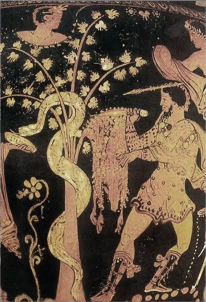
Jason retrieiving a Shroud of Eden
Many mythological legends and events have been linked to the Pieces of Eden. In Greece, the hero Perseus used a Sword of Eden against a Writhing Dread, a creation of the Project Olympos who is known in myths as the gorgon Medusa.[7] One of the twelve labors of Herakles involved the retrieval of Apples of Eden, and the central focus of Jason's quest with the Argonauts was the recovery of a Shroud of Eden called the Golden Fleece.[8] Some of these heroes fought the hybrids of the Project Olympos, as the Minotaur was slain by the king Theseus, the Cyclops was blinded by Odysseus, and the Sphinx was outsmarted by Oedipous.[7] An Apple of Eden was also the cause of the Trojan War.[9]
Biblical mythology
In the Hebrew Bible, many figures realized miracles with Pieces of Eden. Joseph, son of Jacob, was in possession of a Shroud of Eden. The prophet Moses used a Staff of Eden to create an illusion that he parted and closed the Red Sea. The King David used a Shroud of Eden during his fight with Goliath.[8]
Ancient Egypt
A long time ago, the Isu known as Isis used the Ankh of Eden to resurrect her husband Osiris and shared an intimate moment with him before he died a second time.[10]

Queen Nefertiti holding an Apple of Eden
During the 14th century BCE, the Pharaoh Amenhotep IV acquired an Apple of Eden. Believing it was the god Aten itself, he took the name Akhenaten and, with his wife Nefertiti, introduced a new monotheistic religion to Egypt.[11] When he died, his son Smenkhkare created the Order of the Ancients with the aim of identifying and exploiting the Pieces of Eden.[12] After his death, his brother Tutankhamun restored the traditional polytheistic religious system in Egypt and gave the Apple to the High Priests of Amun in Karnak.[11]
At the end of the 8th century BCE, the Pharaoh of Egypt Shabataka possessed a Staff of Eden.[8]
Classical Greece
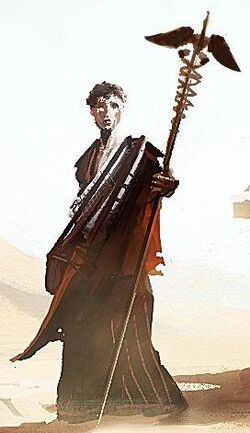
Hermes and his staff
During the 6th century BCE, the Greek scholar Pythagoras was contacted by the Isu Hermes Trismegistus who gave him his Staff, granting him immortality. One of his disciples, Kyros of Zarax met the Isu Aphrodite and received an Apple of Eden that he used to win a race against Atalanta and marry her.[13]
Later, Pythagoras found the Cult of Hermes, a group dedicated to the teachings of Hermes Trismegistus. A faction of Hermeticists led by Agamemnon broke away to form the Cult of Kosmos. Under the Sanctuary of Delphi, they uncovered a pyramidal Piece of Eden which could share memories and visions of the future. With its power, the Cult forced the Pythia to serve as their puppet and sow discord across Greece for their own interests.[7]
During the invasion of Greece by King Xerxes I of Persia, King Leonidas I of Sparta, led the Spartans into war against the Persians with an Isu spear in his hand. When he made his last stand at the Battle of Thermopylae in 480 BCE, the shaft of the spear was broken, but the spearhead was recovered and given to his daughter Myrrine who in turn passed it onto to her daughter, Kassandra. Kassandra which grow up to become a legendary misthios at the height of the Peloponnesian War, using the Spear of Leonidas in all her military escapades. Conversely, the Sword of Damokles, a Sword of Eden, found its way into the hands of her half-brother Alexios who was abducted by the Cult of Kosmos, renamed Deimos, and indoctrinated into becoming their most powerful warrior.[7]
With the Spear, Kassandra fought and destroyed the Cult of Kosmos, defeated Alexios, and destroyed the Pyramid. She also recovered the Atlantis artifacts by killing the hybrids of Olympos Project and sealed the Atlantis with it. After that, the Isu Aletheia sent a message to her father Pythagoras asking him to give her the Staff of Hermes Trismegistus. Kassandra became immortal and learned how to use the Staff through Aletheia's simulations. When the power of the spear faded away, Kassandra gave it to her friend Herodotos who was buried with it.[7]
Hellenistic Age
Conquests of Alexander the Great
During the 4th century BCE, the Order of the Ancients entrusted to the King Alexander the Great the Trident of Eden, a Staff of Eden combined with three prongs which had different powers: Faith, Fear and Devotion. With the Trident, Alexander conquered Egypt and Persia.[14] After his assassination by Iltani, Alexander was buried in his tomb at Alexandria with the staff while the prongs were shared between his generals.[12] Ptolemy I Soter received the Faith prong while Seleucus I Nicator received the Fear prong, and the Macedonian people received the Devotion prong.[14] Two Memory Seals were also hidden under the Library of Alexandria at the time of Alexander.[15]
Twilight of Ptolemaic Egypt
By 49 BCE, the Order of the Ancients had acquired an Apple of Eden. A group led by the proconsul of Cyrenaica, Flavius Metellus, went to the remote Egyptian village Siwa and kidnapped the Medjay Bayek and his son Khemu to force him to open a Isu vault under the Temple of Amun. They had hoped that the mysteries within the vault would grant them more power or access to other Pieces of Eden. As the Medjay resisted, Flavius Metelluskilled his son before leaving Bayek for dead. After that, the Oracle of Amun and Ancient Medunamun kept the artifact and tyrannized the village of Siwa. A year later, Bayek returned and beat to death Meduamun with the Apple. He subsequently journeyed to Alexandria, where he passed the Apple to his wife Aya who in turn entrusted the artifact to Apollodorus, a loyal follower of the Pharaoh Cleopatra.[12]
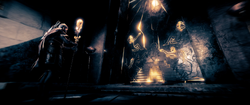
Flavius using the Staff to open the Siwa Vault
During the Alexandrine Civil War, the Ancients recovered the Staff of Alexander the Great and convinced Julius Caesar and Cleopatra to ally with them, lending the Staff to Cleopatra for a time after the end of the civil war. The Order seized back the Staff and murdered Apollodorus to recover the Apple. Returning to Siwa, Flavius Metellus opened the vault by combining the Apple and the Staff. Within the vault, he discovered a holographic map revealing the locations of other Pieces of Eden. This map was downloaded by the Apple. After that, the Ancient Lucius Septimius took the Staff to Rome where he gave it to the Order while Flavius Metellus kept the Apple and used its power to mentally enslave the people of Cyrenaica. When he was confronted by Bayek at the Temple of Mars, he again relied on the device to try to defeat the Medjay, but it was all for naught as his nemesis managed to slay him anyways. Later, the Medjay hid the Apple under the Library of Alexandria.[12]
In the meantime, Septimius himself had in his possession the Flails of Eden. Adopting these as his signature weapon, he wielded them in personal combat against Aya at the Theatre of Pompey, but like Flavius Metellus before him, his advantage proved inadequate, and he was killed by Aya. Not long afterwards, Aya and Bayek founded the Hidden Ones to counter the Order of the Ancients, and she rallied a group of Roman senators to assassinate Julius Caesar.[12] When these senators, chief among them Marcus Junius Brutus and Gaius Cassius Longinus, perished in the ensuing war against Caesar's adopted son Octavian, the Hidden Ones desperately tried to resurrect Brutus with the original Shroud of Eden. They were devastated to find that at most, they could only reanimate him for a brief moment.[16]
Curse of the Pharaoh
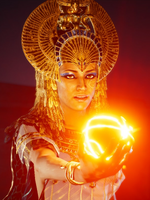
Isidora using the Apple
In 38 BCE, the God's Wife of Amun Isidora used the Akhenaten's Apple of Eden against the tomb robbers of the Valley of the Kings to avenge her mother's death. The power of the Apple created illusions of undead pharaohs who attacked the citizens of Thebes, causing them to believe that there was a curse.[11] Bayek, having heard rumors of golden light on the road to Thebes, reached the Seth-Anat Tomb and fought undead soldiers. In the tomb, he met a man who tasked him to recover a stone which was in the tomb. After returning the stone, the man disappeared and Bayek was defeated by undead soldiers. When he woke up, a woman explained that he was found in the desert. As he tried to tell his story, the woman thought he had only been hallucinating. Bayek decided to investigate the city.[17]
Bayek received a letter from Aya who explained to him that a Piece of Eden was hidden in Thebes. Just when he arrived, he was attacked by a vision of Nefertiti. While investigating the city to find the Piece of Eden, Bayek met Isidora, who hid the truth and told him that he must fight the curse by appeasing the pharaohs in the afterlife, that is the Aaru and the Aten. When Bayek uncovered the truth, he killed Isidora and tasked to the robber Sutekh to hide the Apple. Later, Bayek found the corpse of Sutekh, not knowing if he accomplished his mission.[11]
Beginning of Christianity
During the 1st century CE, a man known as Jesus Christ came to possess a Shroud of Eden in Roman Judea and became a prophet. He was baptized by John the Baptist, a man who in turn had a Staff of Eden. As the Order of the Ancients wanted the Shroud, they crucified Jesus to recover the artifact but his disciples recovered his body and used the Shroud on him in the hopes of reviving him. Three days later, his corpse disappeared.[8]
One of Jesus' disciples, Saint Peter possessed a Staff of Eden and became the leader of the Christian community in Rome. Later, the Staff was passed to every leader of the community, who in time came to be known as the pope, the highest authority in Christendom.[8]
During the Roman Empire, the Caesars recovered the Faith and Devotion prongs. They were later given to the popes.[14]
During the 3rd century CE, the bishop of Paris Denis seemed to have in his possession an Apple of Eden which was encased in a lantern.[18]
Germanic & Hunnic invasions
During the 1st century CE, the Ankh of Eden was found by Roman looters in a pyramid before being sold to an Egyptian slave trader. The Roman Hidden Ones Lugos acquired the artifact and also the Scepter of Aset. During his journey on the Mediterranean Sea, Lugos' ship sank. Before he died the Hidden Ones recorded a message with the Ankh to detail the location of the Scepter.[19]
By 259 CE, the Alemanni Hidden Ones Accipiter was in possession of the Ankh. He gave the artifact to his cousin Aquilus who was also a Hidden Ones from Lugdunum. Aquilus entrusted the Ankh to his father Lucius but he was killed by the senator and member of the Order of the Ancients Caïus Fulvus Vultur, who took the Ankh with him to Rome. [10]
Later, Aquilus killed Vultur and took back the Ankh. When he tried to use it, a hologram of his father appeared but it was stopped when Aquilus and his wife Valeria were arrested by Roman soldiers. Aquilus was executed but Valeria was saved by Accipiter who tasked her to hide the Ankh.[19]
During the 5th century CE, Attila the Hun came to possess a Sword of Eden which permitted him to conquer the most part of Europe. A century later, the proto-Templar Arthur also possessed a Sword of Eden known as Excalibur which he used to fight the Saxon invaders.[8]
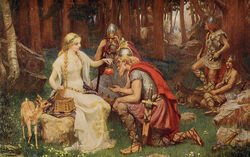
Idun and the Apples of Eden
In Norse mythology, the goddess Idun was the keeper of apples that gave eternal youth. In reality, these were Apples of Eden. The god Odin plunged a Sword of Eden into the tree Barnstokkr which was pulled out by the warrior Sigmund.[8]
During the 10th century, the emperor Otto I was in possession of the Devotion prong. In 965, he passed the artifact to the bishop Poppa who evangelized Denmark and baptized the Templar and King of Denmark Harald Bluetooth. For two decades, Harald kept the prong, using its power to subtly turn foes into allies. Until 984, when Harald was forced into an alliance by his brother-in-law, Styrbjörn the Strong, who was immune to the power of the prong. During their war campaign against Styrbjorn's uncle, Eric the Victorious, the Prince took Harald's prized prong as a guarantee to prevent the Danish King from betraying him. Harald nevertheless decided to flee, and Styrbjorn kept the artifact, unaware of its true power. Styrbjörn later offered, what he believed to be a Christian relic, to the gods during his wedding to Thyra Haraldsdottir.[20]
Sent by Eric to assassinate the Prince, the Assassin Thorvald Hjaltason witnessed the wedding and took the "Aesir blade" from the shrine after their departure. After the Battle of Fyrisvellir during which Styrbjörn was defeated, Thorvald then entrusted the farmer and soldier Östen Jorundsson with hiding the prong where no one could find it. Östen buried the artifact on his lands where it remained for almost a thousand years.[20]
Tang dynasty
During the 10th century, an Apple of Eden was used to develop Firearms in China.[8]
Crusades
- "What of these artifacts? Messages in a bottle? Tools left behind to aid and guide us? Or do we fight for control over their refuse, giving divine purpose and meaning to little more than discarded toys?"
- ―Altaïr Ibn-La'Ahad's Codex, page 5.[src]
During the 12th century, the Knights Templar participated in the Crusades, aiming for the conquest of the Holy Land. By the time of the Third Crusade, they were led by Grand Master Robert de Sable and had focused their efforts on obtaining a particular Piece of Eden: the Apple of Eden of Bayek which was hidden in the ruins of Solomon's Temple beneath the city of Jerusalem.[9]
Seeking the Apple to aid them in their mission and ensure their rule, the Templars used the cover of the Third Crusade to infiltrate the temple. However, one of their own betrayed them; Al Mualim, the Mentor of the Assassin Order who had secretly been allied to them, had sent his best agents to procure the device. Altaïr Ibn-La'Ahad, Malik Al-Sayf, and Kadar Al-Sayf intercepted the Templars, and the two parties engaged one another. While the Templars were able to eject Altaïr from the battle and kill Kadar, Malik successfully captured the Apple and spirited it back to the Assassin fortress in Masyaf.[9]
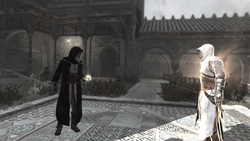
Al Mualim using the Apple on Altaïr
When Al Mualim had the Apple, the Mentor wanted to use the power of the artifact to create peace in Holy Lands. He began by bewitching the Assassins and villagers of Masyaf. He was confronted by Altaïr who discovered the treachery of his Mentor. Al Mualim used illusion from the Apple to defeat his apprentice but Altaïr killed him and took the artifact.[9]
Soon after Al Mualim's death, the Assassin Abbas Sofian took the Apple of Eden to impeach Altaïr to take control of the Brotherhood but he couldn't resist the power of the Piece of Eden. Altaïr stopped the artifact before it could kill Abbas or other residents of Masyaf.[21]
Originally intending to destroy the Apple, Altaïr found himself unable to do so, and instead decided to seal the Apple in the Limassol Archives. Circumstances worked against this plan however, and he decided to keep the Apple for himself, not just to prevent it from falling into the wrong hands but also as a vital object of research.[22]
Over the course of his life, Altaïr gazed into the Apple frequently, basing new weaponry and assassination techniques on information gleaned from it. He recorded some of what he learned from the Apple in his Codex. As Abbas Sofian, who usurped the role of Mentor, tried to take the Apple, Altaïr went in exile in Alamut, where he found a Precursor Temple with at least six Memory seals. He recorded some of his memories on the seals. With the Apple, Altaïr created a Hidden Gun to kill Abbas in 1247.[23]
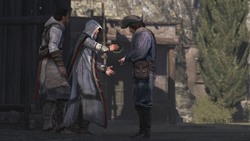
Altaïr giving the seals to Niccolò
In addition to knowledge useful for the Order's purposes, Altaïr witnessed visions of the past and future within the Apple, some of which greatly disturbed him.[3] In 1257, at the end of his life, he secured the Apple within a wall of the his library in Masyaf, which could only be accessed by an individual bearing five of his recorded Memory Seals. He entrusted the seals and his Codex to Niccolò et Maffeo Polo who hid the Seals in the underground of Constantinople.[24] Altaïr kept the last seal to record his last moment.[25]
Mongol Empire

Gengis Khan with the Sword of Eden 2
At the beginning of the 13th century, Genghis Khan acquired a Sword of Eden which he used to conquer most part of Asia and Middle East. Altaïr and his family tried to steal the Sword during their mission in Mongolia but they only assassinated Genghis.[26] Later, his grandson Hülegü Khan used the Sword during his conquest of the Levant in 1250. During the Fall of Masyaf, the Sword protected him from the power of Altaïr's Apple.[27]
By 1259, Möngke Khan was in possession off the Fear prong. When he was killed by the Chinese Assassin Zhang Zhi, the Khan was buried with the artifact.[28]
Mamluk Egypt
Around 1250, the Scepter of Aset was recovered by an Italian fisherman. It then was entrusted by an Egyptian Assassin who gave the artifact to the Mamluks in Cairo. In 1257, Darim Ibn-La'Ahad, Altaïr's son, gave an Apple of Eden to further help the Mamluks revolt.[29]
In 1341, the Templars tried to recover the scepter while the Assassin Numa Al'Khamsin impeded their efforts. His disciple Ali Al-Ghraib hid the scepter in a well where it stayed for centuries.[29]
High Middle Age
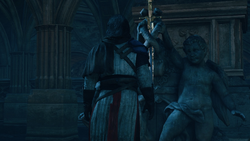
De Molay's advisor hiding the Sword
At the beginning of the 14th century, the Grand Master Templar and Sage Jacques de Molay was in possession of the Sword of Eden 1 and the Heart, which granted more power to the Sword. During the Persecution of the Templars in 1307, the two artifacts were separated. The Sword was hidden in a vault under the Temple of Paris by Jacques de Molay's advisor while the Grand Master carved the Heart in the wall of his cell in the Château de Chinon.[30]
In 1350, the Brothers of the Cross, a Templar faction searched the Ankh of Eden in the city of Essen in Germany. The group mysteriously disappeared at the same moment than the Assassin Lukas Zurburg.[31]
In 1429, the peasant and Assassin ally Jeanne d'Arc recovered the Heart at Chinon and the Sword underneath the Church of Sainte-Catherine-de-Fierbois and used the artifacts during the Hundred Years' War to lead the French Army against the English. After the arrest of Jeanne, the Templars recovered the Sword while Jeanne gave the Heart to the former prostitute Fleur as she took her the place on the stake. As the Heart was found intact in the remains of the stake, the executioner Geoffroy Thérage threw it in the Seine, believing to have killed a saint.[30]
During the 14th century, the Templar Geoffroy de Charny possessed the original Shroud of Eden and in 1356 the Italian Brotherhood of Assassins stole the Piece of Eden before hiding it under the Villa Auditore in Monteriggioni.[32]
Ming dynasty
At the beginning of the 15th century, the Chinese Brotherhood of Assassins possessed an Apple of Eden that an apprentice was tasked to protect. After the Assassin purge of 1402 launched by the Yongle Emperor and the Templars, the apprentice fled with the Assassin Li Tong, who became the keeper of the Apple of Eden.[31]
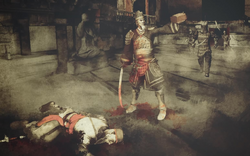
Zhang Yong taking the precursor box on the body of Wang Yangming
In 1526, the Assassin Shao Jun returned in China with a Precursor box gave by the retired Italian Mentor Ezio Auditore da Firenze. To approach her Templar targets, the Eight Tigers, she decided to be captured with the box to assure her a chance to survive. The Tiger Gao Feng took the box and sent it to his Tiger brother Yu Dayong before being killed by Shao Jun. Later, the Assassin killed Yu Dayong in Macau and recovered the box. She entrusted the artifact to her Mentor Wang Yangming who went to Nan'an to find some people who can examine the box. Wang was killed by the leader of the Tigers Zhang Yong who took the box and sent it out of China to other Templars.[33]
By 1542, the Jiajing Emperor had come to possess a Crystal Skull. Using the artifact, he initiated contact with the Italian Assassin Giovanni Borgia, who had recovered another Crystal Skull from the Aztec city of Tenochtitlan.[34]
In June 1582, the Chinese Assassin Liu Yan brought a Sword of Eden to China from Japan to ensure the protection of the artifact.[27]
Age of Discovery
Ottoman Empire
By 1454, an Apple of Eden had fallen into the hands of Sultan Mehmet II of the Ottoman Empire. Using its powers, Mehmet was able to conquer Constantinople and subdue the Byzantine Empire, taking Constantinople as his new capital.[35] Mehmet II died in 1481 and he was succeeded by his oldest son, Bayezid II. Bayezid's brother Cem, a secret Templar, discreetly took his father's Apple of Eden for himself, hoping to use it to further the Templars' goals. However, to his dissatisfaction, the Apple refused to communicate with him despite his attempts to use it.[35]
Cem eventually decided to leave the Apple for European Templars to retrieve later. While on his way to meet the Knights Hospitalier on Rhodes, Cem made a stop in Cyprus and hid the Apple in the Templar Archive in Limassol, where the western Templars could find it.[35]
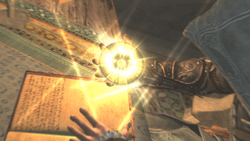
Ezio Auditore studying a memory seal
After the earthquake of 1509 in Constantinople, the Byzantine Rite of the Templar Order led by the Prince Ahmet, Cem's nephew, discovered a secret room under the Topkapı Palace containing one of Altaïr's memory seals. The seal was given to the Templar and heir of the Byzantine Empire Manuel Palaiologos. In 1511, the Italian Mentor Ezio Auditore arrived in Constantinople with Niccolò Polo's journal and with the help of the librarian Sofia Sartor the Assassin recovered the four other memory seals and experienced the memories of Altaïr. To recovered the last seal, Ezio went to Derinkuyu where the Byzantine remnants were hiding and killed Manuel Palaiologos in March 1512.[4]
Later, to force Ezio to give the seals, Ahmet took Sophia Sartor as a hostage. With the help of the Ottoman Brotherhood of Assassins, Ezio saved Sofia and recovered the seals. Then he went to Masyaf and opened the Altaïr's library where he found the sith seal viewing the last moment of the Levantine Mentor and where he hid his Apple of Eden. When Ezio entered in contact with the artifact, Ezio was connecting by a Synch Nexus to his descendant Desmond Miles to deliver a message from the Isu Tinia.[4]
In 1516, the Greek Brotherhood of Assassins was protecting an Apple of Eden. The rogue English Assassin Hiram Stoddard attacked the Assassin's hideout to recover the artifact and contact his deceased lover Elena. After killing the Assassins, Stoddard was ambushed by the Italian Assassin and old rival Giovanni Borgia who bested him and took the Apple before trying to convince him to return in the Brotherhood.[36]
Italian Renaissance
In 1454, a Florentine army led by Federico da Montefeltro besieged Monteriggioni to take the Shroud of Eden. The town's ruler and leader of the Italian Assassins, Mario Auditore, defeated the invaders and entered into the vault where the artifact was hidden. To protect the city, Mario entrusted the Shroud to his brother Giovanni, who gave it to a cell of Assassins led by Rinaldo Vitturi located in Agnadello.[37]
In 1488, the Roman Rite of the Templar Order led by the cardinal and Grand Master Rodrigo Borgia recovered the Apple of Eden left by Cem in the Templar library in Cyprus and brought the artifact to Venice to open the Vatican Vault. Ezio Auditore, who wanted to kill Rodrigo to avenge the deaths of his father Giovanni and his brothers Federico and Petruccio, impersonated the escort of the artifact to approach the Grand Master. With the help of the Italian Assassins, Ezio scared away Rodrigo and recovered the Apple.[38]
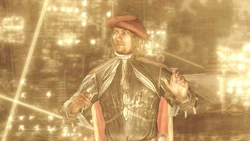
Leonardo seeing projections from the Apple
After being formally inducted in the Brotherhood, Ezio and the Assassins brought the Apple to Leonardo da Vinci to study the artifact. After agreeing that the Apple would be dangerous if it fell in the wrong hands, Ezio was tasked with the Assassin Niccolò Machiavelli to escort the Apple to Forlì where it would be entrusted to their ally Caterina Sforza. When they arrived, the city was attacked by the brothers Ludovico and Checco Orsi, who were hired by Rodrigo to recover the artifact. During the battle, Checco stole the Apple to Caterina but was later killed by Ezio who was severely wounded. While he was unconscious, the Apple was taken by the monk Girolamo Savonarola.[39]
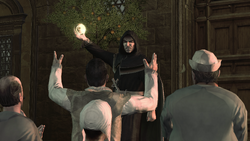
Savonarola using the Apple on Florence's citizens
In 1492, Rodrigo became pope under the name of Alexander VI and received the Staff of Eden which, combined with an Apple of Eden, could open the Vatican Vault. In 1494, Savonarola took control of Florence by using the Apple to bewitch his lieutenants. Alexander sent his men to recover the artifact. By 1497, Ezio arrived in Florence and with the Assassins created an uprising against Savonarola by killing the monk's lieutenants. In 1498, Ezio recovered the Apple after Savonarola was attacked by a mob.[40]
In 1498, Lucrezia Borgia, Rodrigo's daughter, gave birth to a malformed Giovanni Borgia. The father of the child, Perotto Calderon, was an undercover Assassin agent sent to spy on the Borgia. He took his deformed son to Agnadello in the hopes of healing him with the Shroud. Knowing this would constitute a betrayal of the Brotherhood, Perotto killed the Assassins to access to the artifact and successfully cured his son before dying at the blades of the Assassins.[41]
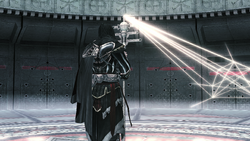
Ezio using the Staff and the Apple to open the vault
In 1499, Ezio confronted Rodrigo in the Sistine Chapel in Rome. During their fight, the Templar used the power of the Staff while the Assassin used the power of the Apple. Rodrigo won the duel, took the Apple, combining it with the Staff to open the Vatican Vault without success. After a fistfight which the Assassin won, Ezio used the two Pieces of Eden to open the vault where he came into contact with the Isu Minerva who showed him the First Catastrophe and the Second that would occur centuries later.[42] Leaving the vault, Ezio tried to recover the Staff, but it was sealed by a trap.[43]
Returning to Monteriggioni, Ezio entrusted the Apple to his uncle Mario, but Cesare Borgia, Rodrigo's son and General of the Papal Army, led a siege on the city, killing Mario and taking the Apple for his father.[44] In Rome, Rodrigo forced Leonardo da Vinci to study the Apple while also letting his grandson Giovanni play with the Apple due to his contact with the Shroud of Eden.[45]
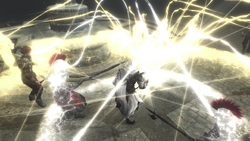
Ezio using the Apple against Cesare troops
In August 1503, Ezio, by then the Mentor of the Italian Brotherhood, recovered the Apple after Rodrigo was killed by his own son. Ezio used it to defeat the forces of Cesare in Rome. After the arrest of Cesare, Ezio used the Apple to foretell that Cesare would escape.[46] Ezio used the Apple to find the Templar until in 1506 when he was tasked by the Apple to hide it under the Colosseum Vault.[47]
In 1509, during the Battle of Agnadello, the condottiero Niccolò di Pitigliano stole the Shroud of Eden under the protection of the Brotherhood. A year later, the Assassin Francesco Vecellio was sent in the city of Lonigo to kill Niccolò and recover the Shroud, two things in which the Assassin succeeded.[48]
In 1515, a then retired Ezio Auditore assigned the Assassin apprentices Hiram Stoddard and Giovanni Borgia to take an Apple of Eden which was in the possession of the Templar Dei Petrucci in Florence. The two Assassins failed in their mission but the Apple was later recovered and sent in Greece.[36]
By 1524, Ezio was in possession of a precursor box that he gave to the Chinese Assassin Shao Jun when she left Italy after he trained her.[49]
Spanish Inquisition
Around 1458, the King Alfonso V of Aragon received the Prong of Faith from the pope Callixtus III. The prong was then handed to the Kings of Spain until 1519.[14]
At the end of the Reconquista, the Spanish Rite of the Templar Order led by the Inquisitor General Tomás de Torquemada tried to take control of Spain using the Pieces of Eden. The Templar and inquisitor Gustavo Ramírez tried to localize three parts of a Staff of Eden in Spain. Ramírez found the first part at the St. Rafael Abbey and entrusted the second part to the monks of the Monastery of St. Lucia. The third part was in the possession of monks of the Asturias mountains who believed it was a part of Saint James' staff. Pedro Madruga, a friend of the Monastery, hid the fragment in his castle of Sobroso to protect it from the Inquisition.[50]
The Spanish Brotherhood of Assassins tried to prevent the Templars from completing the Staff. A team of Assassins infiltrated the Sádaba Castle to steal the first part, but Ramírez fled with it. Then, the Assassins went to St. Lucia and succeeded in taking the second part. They entrusted it to their allies at the Salamanca University.[50]
By 1491, Torquemada discovered that the Assassins had entrusted an Apple of Eden to the Sultan Muhammad XII of Granada. The Templars manipulated Ferdinand II of Aragon and Isabella I of Castile into besieging Granada. To force the Sultan to give the artifact, the Templar Ojeda kidnapped his son Ahmed to proceed to an exchange during the surrender of Granada.[51]
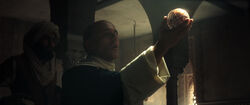
Torquemada contemplating the Apple
When Torquemada received the Apple from the Sultan, the Assassins Aguilar de Nerha and María intervened to take the artifact. During the confrontation, María and Ojeda were killed, but Aguilar fled the city with the Apple. Months later, Aguilar gave the Apple to an ally of the Brotherhood Christoffa Corombo who kept the artifact during his travels to the New World until his death in 1506 and was buried with it.[51]
After the end of the Reconquista, the Templars tortured the monks of the Asturias mountains to uncover the location of the Staff's last section. The Assassins saved the monks who revealed to them where it was. The Assassin Diego de Alvarado, who was a spy of Ramírez, led the Templars to the last part of the Staff before the Assassins. Later, Alvarado killed Ramírez and took the artifact's section in his possession. Alvarado broke into Salamanca University and stole the last section of the Staff.[50]
Alvarado handed all the parts of the Staff to Torquemada, who completed the artifact. In 1498, Torquemada went to the Saint Thomas Aquinas' Monastery in Ávila which was constructed on top of an Isu forge. Using the Forge and the Staff, Torquemada created ghost-like guards and prepared to take control of Spain. The Assassins infiltrated the Forge, killed Torquemada and his ghost army, and destroyed the Staff which was buried under the ruins of the site as the Forge collapsed on itself.[50]
Spanish conquest of America
In 1519, the conquistador Hernán Cortés received the prong of Faith from the King of Spain Carlos I to help him during his expedition in Mexico. During his campaign against the Aztec Empire, Cortés used the prong to give hope to his troops who were outnumbered and also turned some of the natives to his cause.[14]
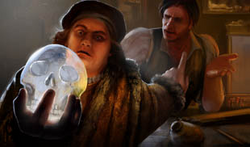
Giovanni and Bombastus studying the Crystal Skull of Mexico
Posing as a chronicler and astrologer, the Assassin Giovanni Borgia infiltrated Cortés' expedition to recover Pieces of Eden in the New World. During the Night of Sorrows, Giovanni assassinated a priest of Tenochtitlan to take a Crystal Skull in his possession. Later, Giovanni returned to Europe with the artifact.[34]
In 1521, the conquistador Juan Ponce de León was influenced by the Templars to explore Florida in the search of the Fountain of Youth, a Piece of Eden alleged to granted eternal youth. Ponce de León was killed by the Assassin Miguel Ramón Carlo de Lugo as the Brotherhood wanted to protect the artifact.[31]
Elizabethan era

The Crystal Ball used by Edward Kelley
By 1559, Altaïr's Apple was in the possession of the Queen Elizabeth I of England. One of her adviser, John Dee, was aware of the nature of the artifact. By 1587, during his time in Bohemia, Dee worked with the English scientist and occultist Edward Kelley, conducting alchemical experiments with the Book of Abraham and a Crystal Ball before returning to England. After the death of the Queen in 1603, Dee sent a cryptic message to Kelley's stepdaughter Elizabeth Jane Weston to inform her about the Apple of Eden.[52]
Feudal Japan
At the end of the Sengoku period, the daimyo Takeda Shingen was in possession of a Sword of Eden. In 1573, Takeda was killed by the Japanese Assassin Hattori Hanzō and the Sword was taken by the daimyo and Assassin ally Oda Nobunaga.[27]
In 1582, as Oda was using the Sword for his own profit, the Assassin Yamauchi Taka killed him and gave the Sword to Liu Yan from the Chinese Brotherhood, who brought the artifact back to her country.[27]
Age of Enlightenment
Golden Age of Piracy
By 1699, the English privateer Captain William Kidd was in the possession of a Ring of Eden which could deflect any metal projectile, giving him a reputation to be invincible. The Templars tried to recover the artifact but Kidd hid it on the Oak Island leaving hints to four members of his former crew.[53]
By 1717, the Dutch slaver and Templar ally Laurens Prins was in possession of the Fragment of Eden, an artifact that could control individuals but also increased the speed and firepower of a ship. In February 1717, the British Assassin and pirate Samuel Bellamy attacked Prins' ship the Whydah and took the artifact. He entrusted it to the French pirate Alonzo Batilla who passed it to another French pirate, Olivier Levasseur. By 1718, Levasseur buried the Fragment on Caicos Islands in the Caribbean Sea to protect it from the Templars.[54]
In August 1718, Levasseur and Batilla recovered the artifact but were ambushed by the ship of the pirate and Templar Christopher Condent. Batilla used the power of the Fragment to sink Condent's ship. As a British fleet led by the Templar pirate-hunter Woodes Rogers arrived, Levasseur fled with the Fragment while Batilla attacked the fleet to give enough time to his friend to escape.[54]
In 1719, the Sage and pirate Bartholomew Roberts entered in the Observatory in Jamaica and took a Crystal Skull that he used with Blood vials to spy important ship cargo and became the richest pirate of this time.[55] In 1722, the former pirate turned Assassin Edward Kenway killed Roberts and took the Crystal Skull.[56] He used it to track the Grand Master of the West Indies Rite of the Templar Order Laureano de Torres y Ayala in Havana.[57] As it was a trap, Kenway returned the artifact to the Observatory where it would be watched over by the West Indies Brotherhood of Assassins.[58]
Georgian Britain
After his journey in the West Indies, Edward Kenway returned to England and settled in London, becoming the co-leader of the British Brotherhood of Assassins around 1723. During his travels in Europe and the Middle-East exploring Isu sites, Edward discovered an Isu cache with a Shroud of Eden in it. Edward secreted it away in the Tower of London while he hid the key in St. Paul's Cathedral.[1]
After Edward's death in 1735, the last leader of the British Brotherhood Miko possessed the Grand Temple Key, bearing it as an amulet. In 1754, Miko was killed by Edward's son, Haytham Kenway, who was a member of the British Rite of the Templar Order, and the Key was stolen. Later, Grand Master Reginald Birch tasked Haytham with finding the Grand Temple in the British Colonies and entrusted him with the Key.[59]
Maroon rebellion in Saint-Domingue
In 1735, a French Templar Admiral possessed Shao Jun's Precursor box. On his way to deliver it to the Madam of La Dame en Rose Bastienne Josèphe in Port-au-Prince, the Admiral was killed by the Assassin and former pirate Adéwalé who recovered the artifact.[60] After a tempest, Adéwalé's ship La Victoire shipwrecked on the shores of Sant-Domingue. The Assassin entered in contact with Bastienne to help each other: Adéwalé will support the Maroon rebellion on the island while Bastienne will secure a way out for the Assassin to leave Port-au-Prince in exchange of the precursor box.[61] After two years, Adéwalé gave the Box to Bastienne before leaving the island.[62]
By 1738, the Mentor of the Saint-Domingue Brotherhood of Assassins François Mackandal began to organize a slave rebellion on Saint-Domingue. He was in possession of the Heart of the Brotherhood which could activate the Prophecy Disk. The slave Jeanne stole the Heart as she was against the violent turn that Mackandal's rebellion took and left Saint-Domingue as she was bought by the French merchant Philippe de Grandpré in 1744.[63]
In November 1751, Mackandal received the Precursor box from Bastienne and used its power to decipher the Voynich manuscript. The Assassins discovered the location of an Isu Temple near Port-au-Prince. Mackandal sent his apprentice Vendredi in the Temple which activated an earthquake. In the panic, the leader of the Templars in British Colonies Lawrence Washington infiltrated the Assassins' camp and stole the Precursor Box and the Manuscript.[64]
Modern times
By 2012, Templar front group Abstergo Industries was in the midst of a project to recover the remaining Pieces of Eden. The Animus Project was set up with the sole intention of locating the Pieces of Eden through the use of the Animus, a device based on Isu technology which allowed an individual to relive the genetic memories of their ancestors.[9]
The Templars sought to manipulate the neurotransmitters that made humanity susceptible to the Pieces' hypnotic effects. To accomplish this goal, they devised the Eye-Abstergo project, which would end in the launch of an "all-in-one telecommunication" satellite into orbit around Earth. However, unbeknownst to the rest of humanity, the satellite would contain an Apple of Eden, and spread its power across the globe.[9]
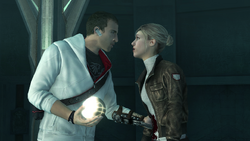
Desmond killing Lucy
On 10 October 2012, an Assassin team of Lucy Stillman, Desmond Miles, Shaun Hastings, and Rebecca Crane located the Apple of Eden hidden by Ezio Auditore beneath the Santa Maria Aracoeli in 1506, discovered by Desmond as he relived Ezio's memories in the Animus. When Desmond touched the Apple, Juno gained access to his nervous system for a brief time. Under Juno's control, Desmond killed Lucy,[65] who was secretly a Templar agent.[66]
Upon release from Juno's control, Desmond fell into a coma, but was able to regain consciousness through achieving a Synch Nexus.[4] Desmond, his father William, Shaun and Rebecca later arrived at the entrance of the Grand Temple in New York, where Desmond used the Apple to open the central chamber gate. It was only then that the Assassins discovered the Grand Temple Key was needed to open the inner gate.[5]
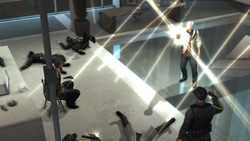
Desmond using the Apple in Abstergo
After William was captured by Templar agents in Cairo while looking for a power source for the Grand Temple, he was brought to Abstergo's Rome facility. Warren Vidic, a member of the Inner Sanctum of the Templar Order and head of the Animus Project, proposed a deal with Desmond to exchange William for the Apple. Desmond travelled to Rome and entered the facility, killing the Abstergo agents and Daniel Cross. Arriving at Vidic's office, Desmond used the Apple to force the facility's guards to shoot Vidic and themselves, then released his father from confinement. Due to Vidic's death and failure to retrieve the Apple of Eden, the Eye-Abstergo project was put on hold indefinitely.[5]
Characteristics and attributes

Bombastus observing a Crystal Skull
Amongst the greatest tools known to man, the Apples of Eden can control the human mind by interacting with a neurotransmitter located deep in the human brain. Other Pieces of Eden are capable of warping reality, creating illusions, ensuring total obedience and healing physical injuries.[3][67] Both Templars and the Assassins believe that the Pieces of Eden were responsible for many historical tales and miracles, such as the Parting of the Red Sea, the Trojan War, the miracles enacted by Jesus Christ, and the Biblical plagues that ravaged Egypt.[9] According to Dr. Álvaro Gramática, all Pieces of Eden are made of an unknown metal resembling gold or silver that Abstergo dubbed 'Pathorica'. [citation needed]
Abilities of the Pieces
Some Pieces of Eden were known to interact with and change the passage of time, possibly creating paradoxes. Others were able to "speak" to those who wielded them, as was the case with Ezio Auditore, Perotto Calderon and Giovanni Borgia, who spoke with Ezio's Apple and the Shroud.[67][68]
When activated, Apples of Eden are capable of extending a pulse of energy that can drive those in the surrounding area to insanity and death. Doing so has a detrimental effect on the physical health of the wielder if they are unskilled in the Apples' use, but a capable user is not as easily afflicted.[65] Altaïr, for example, was able to use Apple #2 for a limited duration without adverse affects at age 92.[4] Using the Pieces' powers in short bursts can also minimize the negative effects dealt by the artifacts, though to what extent is unknown.[3]
Destruction of a Piece
Following the destruction of Apple of Eden #2 during an experiment at the Denver International Airport, the Templars found themselves in need of another artifact with similar properties. Seeking access to a map that indicated the location of all Pieces of Eden, Abstergo kidnapped Desmond Miles in order to view the memories of his ancestor, Altaïr Ibn-La'Ahad. This would allow them to see the very same map that Altaïr discovered in 1191.[9]
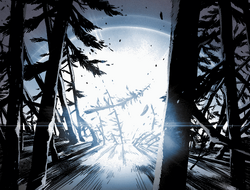
The Tunguska explosion
Each of the Pieces of Eden contained a great deal of potential energy, and the destruction of one could cause an explosion on the scale of a nuclear blast. One such explosion occurred in 1908, in the region of Tunguska, Russia. The Imperial Sceptre, one of the Staves of Eden, was seemingly destroyed when Nikola Tesla fired at the Tunguska facility with his wireless electric weapon, attempting to strike a blow against the Templars.[3][9][69]
However, the blast failed to totally destroy the Staff, and at least one shard remained.[70] The Staff shard still possessed powers of mind control, as demonstrated by Grigori Rasputin. While he was in possession of the shard, he brainwashed Alexandra Feodorovna, the wife of Tsar Nicholas II of Russia, as well as several disciples like Khioniya Guseva.[67]
Resistance
- "I KNOW WHAT YOU'RE DOING. I KNOW WHAT YOU DID. I SAW HIM. HE HAD A METAL BALL. IT OPENED. THEY WENT CRAZY. SHOOTING. STABBING. TORE EACH OTHER TO PIECES. I KNOW IT WAS YOU PEOPLE. SAW THE LOGO. HEARD THE NAME. I'M GOING TO TELL. ANYONE WHO WILL LISTEN. YOU'LL BE EXPOSED. THEY'LL KNOW THE TRUTH. AND THEN YOU WILL PAY. YOU CRAZY BASTARDS. YOU'LL PAY."
- ―An unidentified individual's e-mail to Dr. Warren Vidic.[src]

Altaïr deactivating an Apple
Although the Isu created humanity to be susceptible to the Pieces of Eden, eventual cross-breeding between them and their slaves led to the birth of a hybrid species. These new humans possessed some of the natural abilities of their creators and were free of the neurotransmitter necessary for the Pieces of Eden to control them.[3]
The first two known hybrids were Adam and Eve, who later stole one of the Apples of Eden and instigated the Human-Isu War.[3] Members of their lineage inherited these natural abilities and immunity to the Pieces, although the Pieces' ability to physically manipulate them remained.[9] These traits were passed down through generations to the likes of Altaïr, Ezio and Desmond.[3]
By the early 21st century, the Templars were aware that some humans were immune to the Pieces' mind control. On at least one occasion, Dr. Warren Vidic received an email from an individual unaffected by the Apple's power, who threatened to expose what they had seen when an Apple was used on others.[9]
Confirmed Pieces of Eden
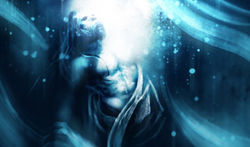
Niccolò di Pitigliano using the Shroud
After seeing the Apple's projection indicating the location of all Pieces of Eden as of 1191, Altaïr copied the map and hid it within his Codex so that only his descendants might find it.[9]
Apples of Eden are all capable of controlling the hearts and minds of humanity, creating illusions and, to a degree, permitting control over physical bodies.[9] The Apples can be used in conjunction with a Staff, which increases the power of both the Pieces of Eden. Other Pieces include the Shroud, which heals the wounds of those it touches on a cellular level; the Ankh, capable of resurrecting the dead; and the Sword, a Piece which can project energy blasts and enhance the charisma of its welders. It was possessed by many great rulers through the centuries, including King Arthur, Genghis Khan and Attila the Hun.[3] A Sword was also in possession of the Knights Templar by 1307, and was subsequently entombed beneath the Temple in Paris. Centuries later, it was recovered by the Grand Master and Sage François-Thomas Germain.[71]
Ratonhnhaké:ton using a Crystal Ball and wearing the Grand Temple Key
The Crystal Skulls were Pieces scattered throughout Central and Southern America which allowed for unassisted telepathic communication between their owners. At one point, a Crystal Skull came into the possession of Giovanni Borgia, who made use of its power in 1542.[67] Similar artifacts known as Crystal Balls allowed users to access the Nexus and communicate with members of the Isu.[67][5] One of the Crystal Balls was notably used by the Assassin Ratonhnhaké:ton to communicate with Juno.[5] In addition, the Assassin Aveline de Grandpré discovered a Prophecy Disk in the Isu Temple of Chichen Itza, which showed her the election of Eve as the leader of humanity's rebellion against the Isu.[72]
In North America, William Kidd discovered a Ring of Eden, which creates a magnetic shield around the user and repels all metallic objects, creating the myth of his "invincibility". There was also the Grand Temple Key which, when combined with three ancient power sources, allowed the holder to open the gate to the inner chambers of the Grand Temple.[5]
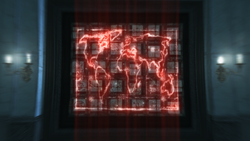
The Codex Map of the Pieces
During the Golden Age of Piracy, an unidentified Piece of Eden in possession of the Templars was stolen by the Assassin Samuel Bellamy, with the help of fellow pirates Olivier Levasseur and Alonzo Batilla. Later, during a confrontation with Templar Christopher Condent, Batilla used the artifact, which increased his ship attacks and defenses, imbuing it with a golden aura, and allowing him to easily sink Condent's significantly more powerful vessel. [54]
According to emails read by Desmond Miles in 2012, at least one Piece of Eden existed that granted the ability to manipulate time. Concerns over possible paradoxes, however, led to Abstergo Industries locking it away.[9] Warren Vidic had a prototype Piece of Eden of his own design, which he used to brainwash Daniel Cross with an impulse to become a high ranking Assassin, so as to get close enough to kill their Mentor. Sebastian Monroe's team discovered the existence of the powerful Trident of Eden, which could manipulate the emotions of individuals -- fear, devotion and faith. [citation needed]
Trivia
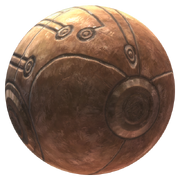
One of the Apples of Eden
- Al Mualim is the first known user and possible coiner of term.
- According to the Glyphs and Truth files, many legends and myths throughout human history are actually historically accurate. The supernatural or paranormal parts of each legend can be explained by the protagonist in each having acquired their own Piece of Eden (i.e. the Greek myth of Perseus, King Arthur, etc).
- During his battle with Rodrigo Borgia in the Sistine Chapel, Ezio created copies of himself, much like Al Mualim did against Altaïr. If Ezio's robes are customized, or if the Armor of Altaïr is worn, his copies appeared with different sets of armor and colors. If he was not customized, each copy would be perfectly identical to the real Ezio, besides his weapon.
- Both the Codex map and the map projection show that there were only fifty Pieces of Eden at that time, though Subject 16 said the Shroud was Piece of Eden 66.
- In the French and German version of Assassin's Creed II, the Shroud was referred to as number 36, not 66. This however, was an oversight.
- The Chalice was initially thought to be a Piece of Eden; however, besides the Shroud, all other artifacts linked to the Christ-figure were confirmed to be merely literary tools.[9]
References
- ↑ 1.0 1.1 Assassin's Creed: Syndicate
- ↑ 2.0 2.1 Assassin's Creed: Odyssey – The Fate of Atlantis: Judgment of Atlantis
- ↑ 3.0 3.1 3.2 3.3 3.4 3.5 3.6 3.7 3.8 3.9 Assassin's Creed II
- ↑ 4.0 4.1 4.2 4.3 4.4 4.5 Assassin's Creed: Revelations
- ↑ 5.0 5.1 5.2 5.3 5.4 5.5 5.6 5.7 5.8 Assassin's Creed III
- ↑ Assassin's Creed Encyclopedia
- ↑ 7.0 7.1 7.2 7.3 7.4 Assassin's Creed: Odyssey
- ↑ 8.0 8.1 8.2 8.3 8.4 8.5 8.6 8.7 AC2 – Glyphs
- ↑ 9.00 9.01 9.02 9.03 9.04 9.05 9.06 9.07 9.08 9.09 9.10 9.11 9.12 9.13 9.14 Assassin's Creed
- ↑ 10.0 10.1 Assassin's Creed 2: Aquilus
- ↑ 11.0 11.1 11.2 11.3 Assassin's Creed: Origins – The Curse of the Pharaohs
- ↑ 12.0 12.1 12.2 12.3 12.4 Assassin's Creed: Origins
- ↑ Assassin's Creed: Project Legacy – Divine Science: Chapter 2 – Kyros of Zarax
- ↑ 14.0 14.1 14.2 14.3 14.4 Assassin's Creed: Last Descendants
- ↑ AC: RV – Mediterranean Defense
- ↑ AC: PL – Holidays: Chapter 1 – Ghosts of Christmas Past
- ↑ ACO – Lights Among the Dunes
- ↑ Assassin's Creed: Unity – Dead Kings
- ↑ 19.0 19.1 Assassin's Creed 3: Accipiter
- ↑ 20.0 20.1 Assassin's Creed: Last Descendants – Fate of the Gods
- ↑ Assassin's Creed: Revelations – The Mentor's Wake
- ↑ Assassin's Creed: Bloodlines
- ↑ Assassin's Creed: Revelations (novel)
- ↑ Assassin's Creed: Revelations – Passing the Torch
- ↑ Assassin's Creed: Revelations – Lost Legacy
- ↑ Assassin's Creed: Reflections
- ↑ 27.0 27.1 27.2 27.3 Assassin's Creed: Memories
- ↑ Assassin's Creed: Last Descendants – Tomb of the Khan
- ↑ 29.0 29.1 Assassin's Creed 6: Leila
- ↑ 30.0 30.1 Assassin's Creed: Heresy
- ↑ 31.0 31.1 31.2 Assassin's Creed: Revelations – Discover Your Legacy
- ↑ Assassin's Creed: Project Legacy – Holidays: Chapter 1 – Ghosts of Christmas Past
- ↑ Assassin's Creed Chronicles: China
- ↑ 34.0 34.1 Assassin's Creed: Project Legacy – Rome: Chapter 4 – Giovanni Borgia
- ↑ 35.0 35.1 35.2 Assassin's Creed: Recollection
- ↑ 36.0 36.1 Assassin's Creed (Titan Comics)
- ↑ Assassin's Creed: Project Legacy – Italian Wars: Chapter 3 – Mario Auditore
- ↑ Assassin's Creed II – Play Along
- ↑ Assassin's Creed II – Battle of Forlì (DLC) – Checcomate
- ↑ Assassin's Creed II – Bonfire of the Vanities (DLC) – Power to the People
- ↑ Assassin's Creed: Project Legacy – Italian Wars: Chapter 4 – Perotto Calderon
- ↑ Assassin's Creed II – In Bocca al Lupo
- ↑ Assassin's Creed: Brotherhood – Mass Exodus
- ↑ Assassin's Creed: Brotherhood – Vilified
- ↑ Assassin's Creed: Project Legacy – Rome: Chapter 2 – Giovanni Borgia
- ↑ Assassin's Creed: Brotherhood – All Roads Lead To...
- ↑ Assassin's Creed: Brotherhood – A Seed
- ↑ Assassin's Creed: Project Legacy – Italian Wars: Chapter 2 – Francesco Vecellio
- ↑ Assassin's Creed: Embers
- ↑ 50.0 50.1 50.2 50.3 Assassin's Creed: Rebellion
- ↑ 51.0 51.1 Assassin's Creed (film)
- ↑ Assassin's Creed: Project Legacy – Divine Science: Chapter 3 – Elizabeth Jane Weston
- ↑ Assassin's Creed III – Oak Island (memory)
- ↑ 54.0 54.1 54.2 Assassin's Creed: Pirates
- ↑ Assassin's Creed IV: Black Flag – The Observatory
- ↑ Assassin's Creed IV: Black Flag – Royal Misfortune
- ↑ Assassin's Creed IV: Black Flag – Tainted Blood
- ↑ Assassin's Creed IV: Black Flag – Ever a Splinter
- ↑ Assassin's Creed III – A Deadly Performance
- ↑ Assassin's Creed IV: Black Flag – Freedom Cry – The Calm Before the Storm
- ↑ Assassin's Creed IV: Black Flag – Freedom Cry – A Common Enemy
- ↑ Assassin's Creed IV: Black Flag – Freedom Cry – De Fayet's Last Stand
- ↑ Assassin's Creed III: Liberation – Jeanne's diary pages
- ↑ Assassin's Creed: Rogue – Tinker Sailor Soldier Spy
- ↑ 65.0 65.1 Assassin's Creed: Brotherhood
- ↑ Assassin's Creed: Revelations - The Lost Archive
- ↑ 67.0 67.1 67.2 67.3 67.4 Assassin's Creed: Project Legacy
- ↑ Assassin's Creed: Brotherhood novel
- ↑ Assassin's Creed: The Fall - Issue #2
- ↑ Assassin's Creed: The Fall - Issue #3
- ↑ Assassin's Creed: Unity
- ↑ Assassin's Creed III: Liberation


